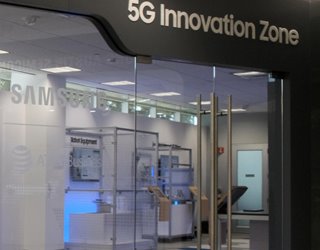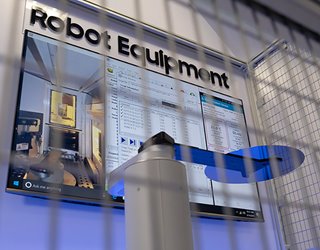Manufacturing Blog: Experience Faster Internet at AT&T’s 5G Manufacturing Zone
Manufacturing Blog: Experience Faster Internet at AT&T’s 5G Manufacturing Zone


AT&T’s 5G Manufacturing Zone at Samsung semiconductor facility in Austin, TX help users experience how 5G will function on the factory floor.
How will 5G internet connections impact the factory floor? If I were an engineer today, working in an automated manufacturing plant filled with robots, conveyors, sensors, and computers everywhere, I would wonder how 5G wireless internet is going to replace or exist in my legacy hardware-wired driven ecosystem.
To help answer this question, AT&T has created the 5G Manufacturing Zone to highlight specific case studies on how 5G will not only change the consumer cellular market but also advance how manufacturing companies will live in a 5G world.
5G Connections and the Manufacturing Industry
The 5G wave is coming soon, and it is getting ready to change how we connect to the internet. 5G will be the fifth generation of modern wireless technology. It promises higher bandwidth and lower latency connections, basically a future world of super-fast connections and the data transfers that will happen in an instance.
Learn More About: Infographic: The State of IoT Devices 2019
According to Statista.com, by 2025, there will be 410 million 5G devices in North America alone. These devices will be capable of internet connection speeds of 10 to 20 gigabits per second, 20 times faster than current 4G networks. For the manufacturing industry, 5G networks will not only accelerate mobile connections but also provide a faster and more secure wireless network for businesses and edge computing.
AT&T’s 5G Manufacturing Zone is in partnership with Samsung. The zone is located at Samsung’s semiconductor manufacturing facility in Austin, TX, and focuses on seven key technology areas based on actual manufacturing work conditions. The Zone launched this past July and is now a permanent fixture of Samsung’s fabrication facility. At the 5G Manufacturing Zone, visitors will be able to experience how 5G will have a positive effect on the manufacturing environment. The seven test areas include:
Recommended for You: The Critical Need for 5G Cellular Service
AT&T chose these areas because they will benefit the most from low latency and high bandwidth connections. “In the demo experience, a visitor on their first day on the job can use a wireless AR headset, powered by a 5G network, to experience operating and repairing a robotic arm,” said David Van Dorselaer, AT&T’s general manager for manufacturing, transportation, and consumer packaged goods. “Being able to use a 5G low latency and high bandwidth network creates an immersive firsthand training experience.”
The 5G Timeline and Obstacles
By 2020, several telecommunication companies will begin to roll out 5G networks. AT&T has already launched mobile 5G in 21 cities and expects nationwide coverage within the first half of 2020. Verizon has already launched fixed 5G for home internet service, and both Verizon and T-Mobile plan to deploy their 5G networks in 2020 as well.
Steve Koenig, vice president of research at the Consumer Technology Association, describes that initial 5G commercial deployments taking place this year in the U.S., South Korea, and China are similar to a child’s first steps.
Read More About: Why We Need 5G Cellular Service
“And just like a child learning to walk, it won’t be long before the child is up and running all over the house,” said Koenig. “In a few years, we will have fully formed 5G networks up and running in a lot of different places around the world.”
Manufacturers are rolling out these different use cases on the factory floor step-by-step. As one application gets implemented, wireless networks are being developed to replace older wired networks.
“Most manufacturing facilities are wired infrastructures. Our approach is that we can help you build upon what you already have,” said Dorselaer. “To create a 5G gateway, we can build a multi-access edge network that connects legacy wired connected devices and wireless 5G Wi-Fi together, and goes all the way to the edge devices for computing locally at the source of the data,”
This helps ease some of the concern’s manufacturers may have of having to replace existing hardware or how much they need to invest in newer technology.
“It is an involved conversation. We want to make sure we don’t disrupt customers that have an environment that’s been in place for 20 to 30 years,” said Dorselaer.“ Besides the network, education of what is possible is key. Legacy wired hardware and 5G wireless technology can coexist.”
To help answer this question, AT&T has created the 5G Manufacturing Zone to highlight specific case studies on how 5G will not only change the consumer cellular market but also advance how manufacturing companies will live in a 5G world.
5G Connections and the Manufacturing Industry
The 5G wave is coming soon, and it is getting ready to change how we connect to the internet. 5G will be the fifth generation of modern wireless technology. It promises higher bandwidth and lower latency connections, basically a future world of super-fast connections and the data transfers that will happen in an instance.
Learn More About: Infographic: The State of IoT Devices 2019
According to Statista.com, by 2025, there will be 410 million 5G devices in North America alone. These devices will be capable of internet connection speeds of 10 to 20 gigabits per second, 20 times faster than current 4G networks. For the manufacturing industry, 5G networks will not only accelerate mobile connections but also provide a faster and more secure wireless network for businesses and edge computing.
AT&T’s 5G Manufacturing Zone is in partnership with Samsung. The zone is located at Samsung’s semiconductor manufacturing facility in Austin, TX, and focuses on seven key technology areas based on actual manufacturing work conditions. The Zone launched this past July and is now a permanent fixture of Samsung’s fabrication facility. At the 5G Manufacturing Zone, visitors will be able to experience how 5G will have a positive effect on the manufacturing environment. The seven test areas include:
- Mixed Reality Training: Using augmented reality to train new workers based on experiences from veteran workers.
- Health and Environmental Sensors: Increase the monitoring capability of a workspace to create a safer environment for workers.
- Automated Material Handling: The use of 4K high-resolution cameras can provide more accurate feedback on production lines to avoid errors.
- Video Security and Analytics: With 4K cameras, companies can enact advanced safety measures that use facial recognition software for smarter security.
- Industrial IoT and Connected Devices: 5G networks enable more connected devices to live on a network, providing real-time data for better monitoring, analytics, and predictive maintenance.
- Robot Equipment: 5G connected internal sensors enable predictive maintenance, and operators can correct system failures wirelessly.
- Enhanced Communications: By having devices connected wirelessly, emergency communications can be delivered faster to ensure worker safety during an incident.
Recommended for You: The Critical Need for 5G Cellular Service
AT&T chose these areas because they will benefit the most from low latency and high bandwidth connections. “In the demo experience, a visitor on their first day on the job can use a wireless AR headset, powered by a 5G network, to experience operating and repairing a robotic arm,” said David Van Dorselaer, AT&T’s general manager for manufacturing, transportation, and consumer packaged goods. “Being able to use a 5G low latency and high bandwidth network creates an immersive firsthand training experience.”
The 5G Timeline and Obstacles
By 2020, several telecommunication companies will begin to roll out 5G networks. AT&T has already launched mobile 5G in 21 cities and expects nationwide coverage within the first half of 2020. Verizon has already launched fixed 5G for home internet service, and both Verizon and T-Mobile plan to deploy their 5G networks in 2020 as well.
Steve Koenig, vice president of research at the Consumer Technology Association, describes that initial 5G commercial deployments taking place this year in the U.S., South Korea, and China are similar to a child’s first steps.
Read More About: Why We Need 5G Cellular Service
“And just like a child learning to walk, it won’t be long before the child is up and running all over the house,” said Koenig. “In a few years, we will have fully formed 5G networks up and running in a lot of different places around the world.”
Manufacturers are rolling out these different use cases on the factory floor step-by-step. As one application gets implemented, wireless networks are being developed to replace older wired networks.
“Most manufacturing facilities are wired infrastructures. Our approach is that we can help you build upon what you already have,” said Dorselaer. “To create a 5G gateway, we can build a multi-access edge network that connects legacy wired connected devices and wireless 5G Wi-Fi together, and goes all the way to the edge devices for computing locally at the source of the data,”
This helps ease some of the concern’s manufacturers may have of having to replace existing hardware or how much they need to invest in newer technology.
“It is an involved conversation. We want to make sure we don’t disrupt customers that have an environment that’s been in place for 20 to 30 years,” said Dorselaer.“ Besides the network, education of what is possible is key. Legacy wired hardware and 5G wireless technology can coexist.”
Carlos M. Gonzalez is special projects manager.







